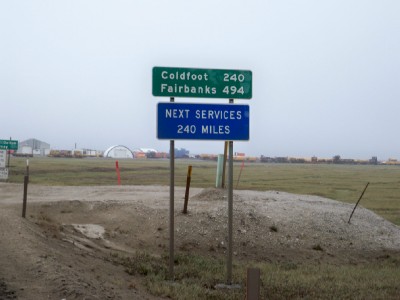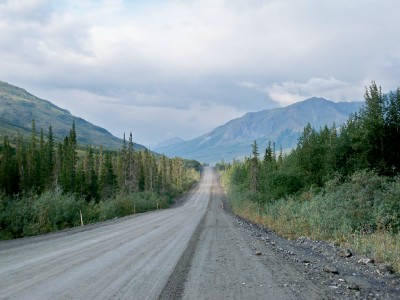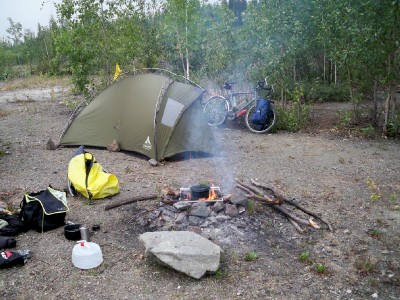Cycling the Haul Road in Alaska is quite a challenge, and detailed guides are scarce. Using my old bicycle touring blog posts, I've created this guide for other cyclists so they might know what to expect when biking the Dalton Highway.

Haul Road / Dalton Highway
The Dalton Highway is a 414-mile gravel road that crosses the Arctic Circle in Alaska. It was originally built as a supply road for the Trans-Alaska Pipeline, and is now open to cyclists, pedestrians (yes, some rare people do it on foot!), and all types of vehicles.
The Dalton Highway starts at the Elliott Highway junction north of Fairbanks, and ends at Deadhorse near the Arctic Ocean. Many people planning a cycle tour along the Pan American Highway prefer to start at Deadhorse Camp (Prudhoe Bay), and then cycle south to Fairbanks.
The distance from Deadhorse Camp to Fairbanks is 495 miles. Or 494 miles once you get to this signpost just outside Deadhorse!

There's a certain logic to this, and indeed that's the direction I rode my bike, but in hindsight, riding this route in the opposite direction, and then catching a ride back down to Fairbanks has slightly more advantages. More on this later.
Note: You might find that the Dalton Highway is also called the Haul Road, or the North Slope Haul Road. It is sometimes also referred to as Alaska Route 11. It's all the same thing!
Cycling the Dalton Highway in Alaska
The Dalton Highway is mostly gravel, with some sections of pavement. The road is very remote, and there are few services available along the way. There are no towns or villages along the Dalton Highway, only a few small “settlements” with a few basic services.
The Dalton Highway is open year-round, but the winter months are extremely cold and dark. The summer months are the best time to cycle the Dalton Highway, although even then the weather can be unpredictable.
Cycling the Dalton Highway is a challenge, both physically and mentally. It is a very remote, and temperatures can dip below freezing at night, even in the summer months. The rolling hills can also be a challenge, as the road is constantly going up and down.

There is also the issue of wind chill, which can make it feel much colder than the actual temperature. Then there are the mosquitoes, which can be relentless in the summer months.
And bears of course!!
Do you need a bear bag or canister cycling the Haul Road?
Bear bags and bear canisters are items used to store food while hiking or camping in areas where bears are a potential risk. Bear bags are soft-sided sacks made of waterproof material and suspended above the ground via rope using a system of pulleys.
Bear canisters, on the other hand, are hard plastic containers that are airtight and durable enough to survive contact with animals such as bears. Both items deter animal encounters through smell protection, reducing the chance of conflict between humans and animals in dense wilderness areas.
I didn't use a bear canister, but did leave my food away from camp in a separate bag. I think I hoisted the bag up into a tree once during the whole trip.
Preparing for your Dalton Highway cycling tour
If you're thinking of cycling the Dalton Highway, then you need to be prepared. Mentally and physically, this is a challenge like no other.
You need to be in good physical shape, and be able to ride long distances, day after day in conditions that can change from one minute to the next.
Mental preparation is just as important. The Dalton Highway is a lonely place, with only occasional truck drivers, motorcyclists and four wheel drive vehicles passing by. You're going to spend a lot of time in your own head, and you need to be comfortable with that.
Of course, you will meet other people at campgrounds or passing by, but when it's you, the hills, and a freezing cold wind, you'll feel like you are in the middle of nowhere. Which you are of course – it's inside the Arctic Circle!
Things to take on a Haul Road bicycle tour
While you've probably got a good idea of what gear to take on a bike tour, there are a few items I'd like to highlight as being particularly important when cycling the Dalton Highway:
First of all, you need a good quality tent. The weather on the Dalton Highway can be extreme, and you need to be prepared for all eventualities. A four season tent is ideal. Three season as a minimum. And make sure you've tested it before you use it for the first time in Alaska!
A good sleeping bag is also essential. Again, four season or three season as a minimum. You will be camping in some pretty cold temperatures, and you need to be prepared for that. A comfortable sleeping mat is also worth taking.
A camping stove is a must. There are no restaurants along the Dalton Highway (well, not every day you will be cycling), and you will need to cook your own meals.
A water filter is also a good idea, as it means you can replenish your water from streams you will find off the main road. Some campgrounds may have potable water, but better to be safe than sorry.
Buy bear spray. Alaska is bear country, and you need to be prepared for an encounter. Bear spray is the best way to deter a bear, but not having any contact with bears is the best way to stay safe.
Good rain gear. You will get wet. It's inevitable. The weather on the Dalton Highway can be unpredictable, and you need to be prepared for all eventualities.
Finally, make sure your bike is in good working order, and that you have all the necessary spares with you. This is a remote road, and there are no bike shops along the way!
Food Supplies along the Dalton Highway
This deserves its own section. There are very limited supplies available along the Dalton Highway, and you need to be prepared for that.
There are a few general stores, but they are few and far between. The best bet is to stock up on food before you start your tour.
Plan what food to take very well!! This is a remote stretch of road, and its not like there are stores on every bend!
You might be interested in this article on what food to take on a bicycle tour. Make sure you have enough fuel for your camp stove, and take some extra supplies just in case the route takes longer than you thought.
If cycling from Prudhoe Bay to Fairbanks, I'd suggest carrying 5 days of food at the very least.
I sent some food to Coldfoot where I picked it up at the post office. This pre-arranging food supplies was new to me, but it worked out well.
Wild Camping
There are a few established campgrounds along the Dalton Highway, but they are few and far between.
Most people end up wild camping for a couple of nights at least. Remember this is bear country!

Which Direction Should I cycle the Dalton Highway?
There are two directions of travel that you can choose from when cycling the Haul Road in Alaska. These are to cycle from the North to South, or from the South to North.
Each one has it's pros and cons. I decided to cycle from North to South. If I were to do it again, I would probably choose the other direction.
The reason for this, is that I caught a tourist bus ride to Deadhorse up to the north which wasn't exactly cheap and cycled down from there.
Going the other way, on arrival in Deadhorse, it is common practise to hang around and see if it's possible to get a free ride back on a truck. This normally takes a couple of days.
I haven't heard of anyone cycling in both directions, I suppose there must be at least one crazy cyclist that has done just that!
Traditional Bike Touring Setup Or Bikepacking Dalton Highway?
A bikepacking setup has its advantages in some situations, but I personally do not think this is one of them. You'll probably need to carry more food and water than you are used to, and a bikepacking setup doesn't really allow for much flexibility.
A traditional touring bike with racks and panniers will give you enough room to carry everything you need, and will be more comfortable to ride over the long distances.
I did it slightly differently, as I used a trailer for this bike tour along the Dalton Highway. I assure you I will never do that again!! Read my article about panniers vs trailers for why!
Note from an old head: If you've got a bikepacking setup and then start wearing a pack on your back, and add two small panniers to the front of your bike – well, it makes more sense to just go with a traditional touring bike arrangement. It's way more comfortable.
When to cycle in Alaska
The Dalton Highway is in the extreme north of Alaska. This means there is only a relatively small window of time that cycling is possible to avoid the snows.
As already mentioned, I started in July. The most common months to cycle the Haul Road are July through to September. Even during this time, there might be snow given the weathers unpredictable nature.
Outside of that time frame, the snow might hinder even the bravest adventure cyclist. Although I haven't heard of any, I suppose at least one person has cycled in the winter!
Interesting note – Cycling the Haul Road in summer will mean that you will experience almost 24 hours of sunlight.
How Long to cycle the Haul Road
It took me 8 days to cycle the Haul Road. This was longer than I anticipated due to injuring my knee. I would say that 6 days would be about average for most cyclists.
My lesson here is that you should over plan how much food you might need, just in case circumstances mean you end up cycling for more days than you initially thought.
My Experiences Cycling Alaska Haul Road
The start of my cycling trip from Alaska to Argentina really threw me in at the deep end! I began up in the arctic circle, on the very edge of civilisation itself. Only one road leads to and from here – The Haul Road.
It is renowned for its long stretches of steep inclines, and unsealed surfaces that can turn to thick mud and strong winds. All of these affected me on this cycling route!
Here's my day by day blog posts from cycling the Haul Road:
- Biking from Deadhorse to Happy Valley
- Biking from Happy Valley to Galbraith Lake
- Biking from Galbraith Lake to Random Roadside
- Biking from Roadside to Marion Creek
- Riding from Marion Creek to Arctic Circle
- Cycling from Arctic Circle to Five Mile
- Riding from Five Mile to Elliot Highway
- Cycling from Elliot Highway to Joy
- Joy to Fairbanks

Other blog posts that may interest you are shown below.